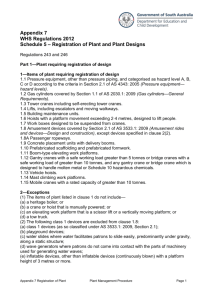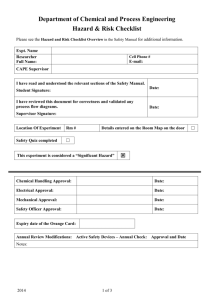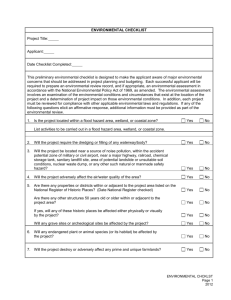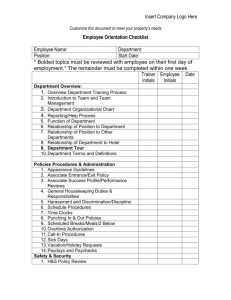Plant Hazard Checklist
advertisement
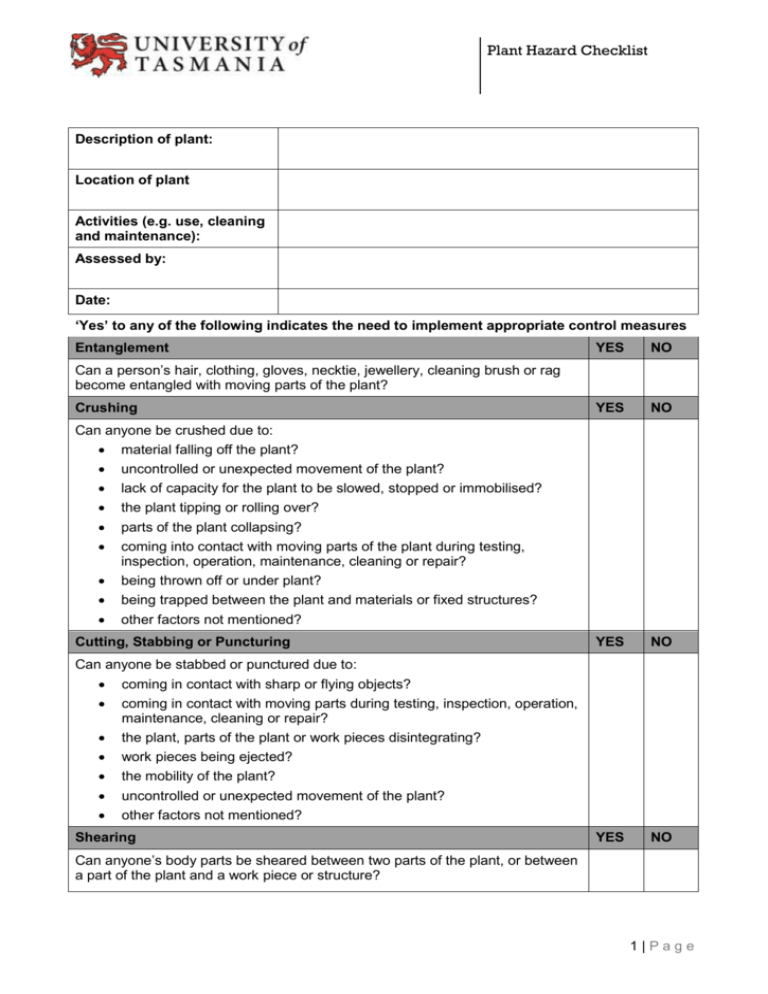
Plant Hazard Checklist Description of plant: Location of plant Activities (e.g. use, cleaning and maintenance): Assessed by: Date: ‘Yes’ to any of the following indicates the need to implement appropriate control measures Entanglement YES NO YES NO YES NO YES NO Can a person’s hair, clothing, gloves, necktie, jewellery, cleaning brush or rag become entangled with moving parts of the plant? Crushing Can anyone be crushed due to: material falling off the plant? uncontrolled or unexpected movement of the plant? lack of capacity for the plant to be slowed, stopped or immobilised? the plant tipping or rolling over? parts of the plant collapsing? coming into contact with moving parts of the plant during testing, inspection, operation, maintenance, cleaning or repair? being thrown off or under plant? being trapped between the plant and materials or fixed structures? other factors not mentioned? Cutting, Stabbing or Puncturing Can anyone be stabbed or punctured due to: coming in contact with sharp or flying objects? coming in contact with moving parts during testing, inspection, operation, maintenance, cleaning or repair? the plant, parts of the plant or work pieces disintegrating? work pieces being ejected? the mobility of the plant? uncontrolled or unexpected movement of the plant? other factors not mentioned? Shearing Can anyone’s body parts be sheared between two parts of the plant, or between a part of the plant and a work piece or structure? 1|Page Plant Hazard Checklist Striking YES NO YES NO YES NO YES NO YES NO Can anyone be struck by moving objects due to: uncontrolled or unexpected movement of the plant or material handled by the plant? the plant, parts of the plant or work pieces disintegrating? work pieces being ejected? mobility of the plant? other factors not mentioned? High Pressure Fluid Can anyone come into contact with fluids under high pressure, due to plant failure or misuse of the plant? Electrical Can anyone be injured by electrical shock or burnt due to: the plant contacting live electrical conductors? the plant working in close proximity to electrical conductors? overload of electrical circuits? damaged or poorly maintained electrical leads and cables? damaged electrical switches? water near electrical equipment? lack of isolation procedures? other factors not mentioned? Explosion Can anyone be injured by explosion of gases, vapours, liquids, dusts or other substances, triggered by the operation of the plant or by material handled by the plant? Slipping, Tripping and Falling Can anyone using the plant, or in the vicinity of the plant, slip, trip or fall due to: uneven or slippery work surfaces? poor housekeeping, e.g. offcuts, cables, hoses obstructing walkways, spills not cleaned up? obstacles being placed in the vicinity of the plant? other factors not mentioned? Can anyone fall from a height due to: lack of a proper work platform? lack of proper stairs or ladders? lack of guardrails or other suitable edge protection? unprotected holes, penetrations or gaps? poor floor or walking surfaces, such as the lack of a slip-resistant surface? steep walking surfaces? collapse of the supporting structure? other factors not mentioned? 2|Page Plant Hazard Checklist Ergonomic YES NO YES NO YES NO Can anyone be injured due to: poorly designed seating poorly designed operator controls? high forces? repetitive movements? awkward body posture or the need for excessive effort? vibration? other factors not mentioned? Combination of hazards Can anyone be injured due to unexpected start-up, unexpected over-run/over-speed (or similar malfunction) from: failure/disorder of the control system, for example, a hydraulic system? restoration of energy supply after an interruption? external influences on electrical equipment? other environmental factors (gravity, wind, etc.)? errors in the software? errors made by the operator ? Other hazards Can anyone be injured due to: noise? inadequate or poorly placed lighting? entry into any confined spaces of the plant? failure to select plant that is suitable for its intended use? contact with hot or cold parts of plant? exposure to hazardous chemicals, radiation or other emissions released by the plant? lack of operator competency? other factors not mentioned? 3|Page Plant Hazard Checklist 4|Page Plant Hazard Checklist REGISTRABLE PLANT A. List of plant requiring registration of design as outlined in Schedule 5 (Part 1) of the WHS Regulations Pressure equipment, other than pressure piping, and categorised as hazard level A, B, C or D according to the criteria in Section 2.1 of AS 4343 Pressure equipment – hazard levels Gas cylinders covered by Part 1.1 of AS 2030.1 Gas cylinders - General Requirements Tower cranes including self-erecting tower cranes Lifts, including escalators and moving walkways Building maintenance units Hoists with a platform movement exceeding 2.4 metres, designed to lift people Work boxes designed to be suspended from cranes Amusement devices covered by Section 2.1 of AS 3533.1:2009 - Amusement Rides and Devices, except Class 1 structures (see below) Concrete placement units with delivery booms Prefabricated scaffolding and prefabricated formwork Boom-type elevating work platforms Gantry cranes with a safe working load greater than 5 tonnes or bridge cranes with a safe working load of greater than 10 tonnes, and any gantry crane or bridge crane which is designed to handle molten metal or Schedule 10 hazardous chemicals Vehicle hoists Mast climbing work platforms Mobile cranes with a rated capacity of greater than 10 tonnes Note: The plant listed as requiring design registration does not include: a heritage boiler a crane or hoist that is manually powered an elevating work platform that is a scissor lift or a vertically moving platform a tow truck certain Class 1 structures including: o playground structures o water slides where water facilitates patrons to slide easily, predominantly under gravity, along a static structure o wave generators where patrons do not come into contact with the parts of machinery used for generating water waves o inflatable devices that are sealed o inflatable devices that do not use a non-return valve. 5|Page Plant Hazard Checklist B. List of plant items requiring registration as outlined in Schedule 5 (Part 2) of the WHS Regulations Boilers categorised as hazard level A, B or C according to criteria in Section 2.1 of AS 4343 - Pressure equipment - hazard levels. Pressure vessels categorised as hazard level A, B or C according to the criteria in Section 2.1 of AS 4343 - Pressure equipment - hazard levels, except for gas cylinders; LP Gas fuel vessels for automotive use, and serially produced vessels. Tower cranes including self-erecting tower cranes. Lifts, including escalators and moving walkways. Building maintenance units. Amusement devices covered by Section 2.1 of AS 3533.1:2009 - Amusement Rides and Devices, except for certain Class 1 structures (see below). Concrete placement units with delivery booms. Mobile cranes with a rated capacity of greater than 10 tonnes. Note: The plant listed as requiring item registration does not include: a crane or hoist that is manually powered certain Class 1 structures: o playground structures o water slides where water facilitates patrons to slide easily, predominantly under gravity, along a static structure o wave generators where patrons do not come into contact with the parts of machinery used for generating water waves o inflatable devices that are sealed o inflatable devices that do not use a non-return valve. 6|Page
